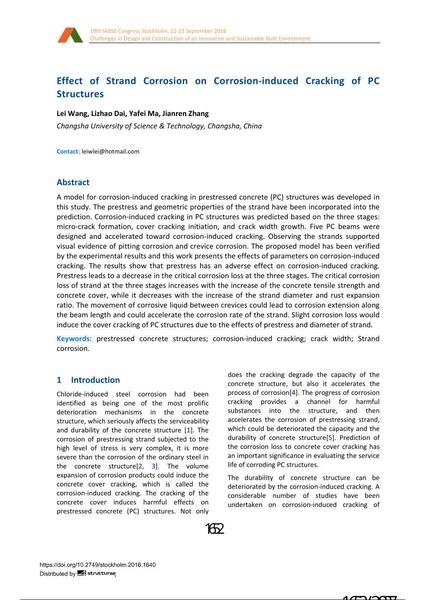Effect of Strand Corrosion on Corrosion-induced Cracking of PC Structures

|
|
|||||||||||
Bibliographic Details
| Author(s): |
Lei Wang
(Changsha University of Science & Technology, Changsha, China)
Lizhao Dai (Changsha University of Science & Technology, Changsha, China) Yafei Ma (Changsha University of Science & Technology, Changsha, China) Jianren Zhang (Changsha University of Science & Technology, Changsha, China) |
||||
|---|---|---|---|---|---|
| Medium: | conference paper | ||||
| Language(s): | English | ||||
| Conference: | IABSE Congress: Challenges in Design and Construction of an Innovative and Sustainable Built Environment, Stockholm, Sweden, 21-23 September 2016 | ||||
| Published in: | IABSE Congress Stockholm, 2016 | ||||
|
|||||
| Page(s): | 1652-1660 | ||||
| Total no. of pages: | 9 | ||||
| Year: | 2016 | ||||
| DOI: | 10.2749/stockholm.2016.1640 | ||||
| Abstract: |
A model for corrosion-induced cracking in prestressed concrete (PC) structures was developed in this study. The prestress and geometric properties of the strand have been incorporated into the prediction. Corrosion-induced cracking in PC structures was predicted based on the three stages: micro-crack formation, cover cracking initiation, and crack width growth. Five PC beams were designed and accelerated toward corrosion-induced cracking. Observing the strands supported visual evidence of pitting corrosion and crevice corrosion. The proposed model has been verified by the experimental results and this work presents the effects of parameters on corrosion-induced cracking. The results show that prestress has an adverse effect on corrosion-induced cracking. Prestress leads to a decrease in the critical corrosion loss at the three stages. The critical corrosion loss of strand at the three stages increases with the increase of the concrete tensile strength and concrete cover, while it decreases with the increase of the strand diameter and rust expansion ratio. The movement of corrosive liquid between crevices could lead to corrosion extension along the beam length and could accelerate the corrosion rate of the strand. Slight corrosion loss would induce the cover cracking of PC structures due to the effects of prestress and diameter of strand. |
||||
| Keywords: |
prestressed concrete structures crack width strand corrosion corrosion-induced cracking
|
||||
